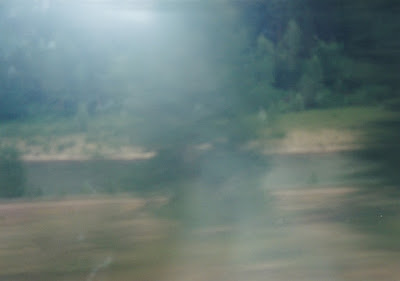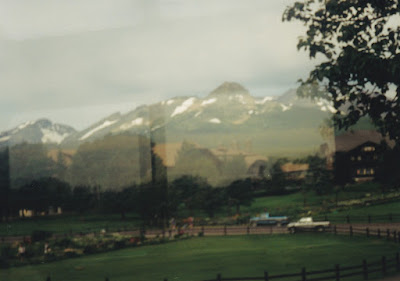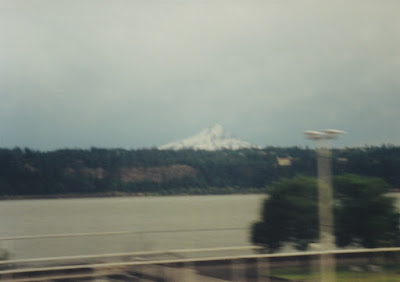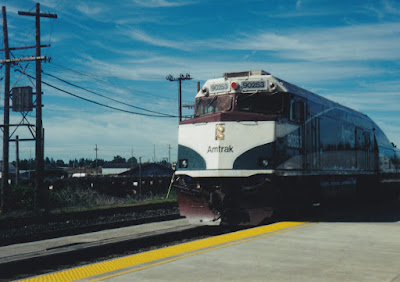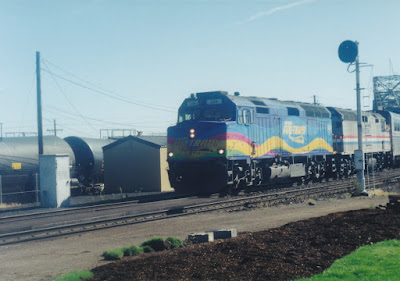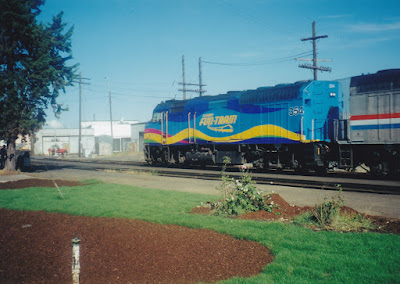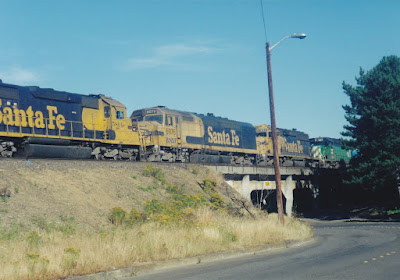Wednesday, December 26, 2018
Eastbound Empire Builder at Midway Station
On July 25, 1999, I was riding Amtrak's eastbound Empire Builder to Milwaukee. That morning the train made its scheduled service stop at Midway Station, serving the Twin Cities of Minneapolis and St. Paul, Minnesota. Parked on one of the tracks was the private car Caritas. The Caritas was built in 1948 by Pullman as a 4-Bedroom, 14-Roomette Sleeping Car for the St. Louis-San Francisco Railway, or Frisco for short. The car was originally named Pierre Laclede after the founder of St. Louis. The car was originally assigned to the Texas Special, which ran between St. Louis, Missouri, and San Antonio, Texas. over the Frisco and the Missouri-Kansas-Texas. The Frisco discontinued its portion of the Texas Special (the northern portion) in 1959. In 1964, this car was sold to the Canadian National and named Churchill Falls. High Iron Travel bought the car in 1983 and rebuilt it to its current configuration, with 3 double bedrooms and a master room, dining area, galley, wine cellar, and lounge.
Part of this eastbound Empire Builder's Superliner consist included a Smoking Coach in the Seattle section. In 1996 and 1997, Amtrak converted 34 of its 48 Superliner I Coach Baggage cars into Smoking Coaches by converting the baggage room on the lower level to a smoking room. This was to give coach passengers a place on the train to smoke without disturbing non-smoking passengers. The Smoking Coaches were converted back to Coach Baggage cars in 2004.
Here are the Empire Builder's locomotives at Midway. Amtrak #817 & #800 are 4,000-horsepower Dash 8-40BPs that were built by General Electric in July & April 1993.
The Empire Builder featured a Heritage Fleet Baggage Car for passenger baggage (except the Portland section, which had Superliner Coach Baggage). On this run was Amtrak #1208, still wearing its Phase III stripes. It was originally built by Budd in 1953 as Atchison, Topeka & Santa Fe #3521. After the formation of Amtrak in 1971 it became Amtrak #1037, and in June 1978 it was converted for Head-End Power and renumbered to #1208.
The Empire Builder carries significantly more coach passengers between the Twin Cities and Chicago than it does on the rest of its route, so an additional coach is often added to the eastbound train at Midway, and removed here on the westbound run. On this run, Superliner I Coach Baggage #31007 was added to the end of the train, behind the sleeping car from Portland. It was built by Pullman-Standard in 1980.
Riding the Eastbound Empire Builder through Montana & North Dakota
July 24, 1999 was the second day of my trip aboard Amtrak's eastbound Empire Builder to Milwaukee, Wisconsin. That morning, the train stopped alongside Great Northern NW3 #181 in Whitefish, Montana. Built by the Electro-Motive Division of General Motors in March 1942 as Great Northern #5406, this 1,000-horsepower diesel locomotive was the last of the only seven NW3s built, all for the Great Northern. It was renumbered to #181 in 1943. On August 30, 1965, the Great Northern sold #181 to Anaconda Aluminum in Columbia Falls, Montana, where it became their #900. When no longer needed, Anaconda Aluminum donated the locomotive to the Stumptown Historical Society in Whitefish, Montana. It was restored to Great Northern colors and placed on permanent static display next to the Whitefish depot on November 19, 1990.
East of Whitefish, Montana, the route of Amtrak's Empire Builder skirts the south edge of Glacier National Park as its parallels the Middle Fork of the Flathead River, as seen here near Nyack, Montana.
In addition to the Middle Fork of the Flathead River, Amtrak's Empire Builder also parallels U.S. Highway 2, which featured red-tinted pavement near Nyack, Montana.
The eastbound Empire Builder is climbing into the Rocky Mountains by this point. Shortly after passing Essex, Montana, the railroad passes through Snowshed #12, the first of a number of structures that protect the railroad from winter slides and avalanches. At the end of Snowshed #12 is this view of the Middle Fork of the Flathead River. The bridge carrying U.S. Highway 2 Bridge over the river is visible in the background.
The eastbound Empire Builder eventually crosses the Middle Fork of the Flathead River near Nimrod, Montana on Java Trestle, at the point where Java Creek flows into Middle Fork of the Flathead River. This view from Java Trestle shows the clear blue water of the Middle Fork of the Flathead River.
Leaving Glacier Park, the eastbound Empire Builder stops at East Glacier, Montana. Visible from the train during the station stop is the Glacier Park Lodge. The Glacier Park Lodge was built in 1913 by the Glacier Park Company, a subsidiary of the Great Northern Railway, and its design was based on the Forestry Building from the 1905 Lewis & Clark Centennial Exposition in Portland, Oregon.
As the eastbound Empire Builder continues out of the Rocky Mountains into eastern Montana. One of the major stops on this part of the trip is Havre, Montana, which is a service stop for the Empire Builder. If the Empire Builder is running on time, it will stop here for about 20 minutes, giving passengers an opportunity to step off the train and stretch their legs.
On static display next to the Amtrak depot in Havre is Great Northern steam locomotive #2584, an S-2 Class 4-8-4 that was built by the Baldwin Locomotive Works in 1930.
This locomotive is an example of the type of locomotives that pulled passenger trains like the Empire Builder through Montana during the age of steam.
A sign next to the locomotive tells its history:
THIS NORTHERN TYPE LOCOMOTIVE, SURVIVOR OF THE LAST STEAM ENGINES ACQUIRED BY THE GREAT NORTHERN RAILWAY FOR MAIN-LINE PASSENGER SERVICE, WAS PLACED ON PERMANENT EXHIBITION HERE ON MAY 15, 1964.
A POWERFUL AND SPEEDY LOCOMOTIVE, THIS ENGINE NOW LOOKS EVERY BIT THE ARISTOCRAT THAT IT WAS DURING THE YRS. OF ITS PRE-EMINENT ASSOCIATION WITH THE EMPIRE BUILDER AND THE ORIENTAL LIMITED. THE EMPIRE BUILDER WAS INAUGURATED ON JUNE, 1929, AND WAS PULLED BY A MOUNTAIN TYPE LOCOMOTIVE, BUT POPULARITY OF THE TRAIN LED TO ADDITION OF CARS TO THE CONSIST, AND THIS NECESSITATED MORE POWERFUL ENGINES.
IN 1930 GREAT NORTHERN ACQUIRED 14 CLASS S-2 STEAM LOCOMOTIVES FROM BALDWIN LOCOMOTIVE WORKS FOR SERVICE ON THE EMPIRE BUILDER AND THE FAST MAIL TRAINS. THIS ENGINE - No 2584 - IS THE LAST OF THE 14 ENGINES. SAMUEL VAUCLAIN, PRESIDENT OF BALDWIN DESCRIBED THE CLASS S-2 ENGINES AS "THE FINEST, MOST POWERFUL STEAM PASSENGER LOCOMOTIVES EVER BUILT UP TO THIS TIME." THESE ENGINES WERE OPERATED IN FREIGHT SERVICE AFTER THE EMPIRE BUILDER WAS STREAMLINED AND DIESEL POWERED IN 1947, AND WERE RETIRED IN 1955.
LOCOMOTIVE AND TENDER ARE 103 FEET 3 INCHES LONG, WEIGHT 764,680 POUNDS, AND HEIGHT FROM RAIL TO TOP OF STACK IS 16 FEET. No 2584 WAS AN OIL BURNER AND DEVELOPED 58,305 POUNDS OF TRACTIVE EFFORT. EACH OF THE 8 DRIVE WHEELS IS 80 INCHES HIGH.
THE TRACK ON WHICH No 2584 STANDS IS LAID TO THE GREAT NORTHERN MAIN LINE SPECIFICATIONS. THE CREOSOTED TIES ARE SUPPORTED ON A SUB-BALLAST CONSISTING OF 6 INCHES OF ROCK CHIPS AND A BALLAST CONSISTING OF SIX INCHES OF CRUSHED PINK QUARTZITE ROCK, BOTH OF WHICH ARE QUARRIED BY THE GREAT NORTHERN IN MONTANA. WELDED RAILS FULLY TIE PLATED AND ANCHORED, WEIGHT 115 POUNDS TO THE YARD.
After departing the Havre depot, the eastbound Empire Builder passes Burlington Northern Santa Fe's Havre yard and engine shop, where Burlington Northern Rotary Snowplow Power Units #972571 & #972570 are pictured. Both were originally built by the Electro-Motive Division of General Motors as 1,750-horsepower F9A diesel locomotives for freight service. Burlington Northern #972571 was built in September 1954 as Northern Pacific #7003A. After the Northern Pacific was merged into the Burlington Northern in March 1970, it became Burlington Northern #812. Burlington Northern #972570 was built in March 1956 as Northern Pacific #7011D. On April 11, 1966 it was reassigned to passenger service and renumbered to Northern Pacific #6704C. After the Northern Pacific was merged into the Burlington Northern in March 1970, it became Burlington Northern #9818. Following the creation of Amtrak in May 1971, it was transferred to freight service and was renumbered to Burlington Northern #784 in July 1973. Both of these locomotives were retired in December 1981 and rebuilt by Burlington Northern as Rotary Snowplow Power Units, or RSPUs. Their traction motors were removed and they were rewired so their diesel engines and main generators could provide power for a rotary snowplow.
Much later in the day, the eastbound Empire Builder reaches another service stop in Minot, North Dakota, where I managed to get a picture of the train's cook in the doorway of the dining car while it was being restocked.
Here are the locomotives for the eastbound Empire Builder being refueled in Minot. Amtrak #817 & #800 are 4,000-horsepower Dash 8-40BPs that were built by General Electric in 1993.
Just to the west of the Amtrak station in Minot, and visible from its platform, is a crossing of the BNSF Railway and the Canadian Pacific Railway. Seen here leading a westbound freight train, Canadian Pacific #8559 is a 4,400-horsepower AC4400CW that was built by General Electric in 1998.
Labels:
4-8-4,
AC4400CW,
Amtrak,
B40-8P,
Baldwin,
Burlington Northern,
CP,
Diesel Locomotive,
EMD,
F-Unit,
General Electric,
Great Northern,
Havre,
Maintenance of Way,
Minot,
Montana,
North Dakota,
NW3,
Passenger Train,
Steam Locomotive
Thursday, November 22, 2018
Riding the Eastbound Empire Builder up the Columbia River Gorge
On July 23, 1999, I boarded the eastbound Portland section of Amtrak's Empire Builder at Vancouver, Washington, on a trip to Milwaukee, Wisconsin. Here are the pictures I took the first day, as the train traveled up the north bank of the Columbia River Gorge. Unfortunately, most of them are blurry, because my camera's autofocus tried to focus on the reflections and dirt on the window glass instead of the scenic views beyond.
Phoca Rock is a landslide remnant that sits in the middle of the Columbia River near Bridal Veil, Oregon, though it is closer to the Washington side of the river. It is about 30 feet tall and was named by William Clark after the Phoca vitulina harbor seals that were seen in the area.
At a height of 620 feet, Multnomah Falls is the tallest waterfall in Oregon and is one of the tallest year-round waterfalls in the United States.
In the background is the spillway of the Bonneville Dam on the Columbia River. The spillway was built from 1933 to 1937 along with the first powerhouse on the Oregon side of the river.
The Bonneville Dam spillway is 1,450 feet long and has 18 gates. It typically maintains the reservoir on the upstream side at a height 59 feet above the river on the downstream side.
The Bonneville Dam Second Powerhouse was built on the Washington side of the river from 1974 to 1982. The river had to be widened to provide space for it.
The Second Powerhouse is 986 feet long with 8 generators producing a total of 558 megawatts of power. Combined with the first powerhouse, the entire Bonneville Dam can produce 1.2 gigawatts of electricity.
This is the Stevenson Co-Ply plywood mill in Stevenson, Washington. Stevenson Co-Ply, Incorporated, was incorporated on August 17, 1955, and purchased the Stevenson Plywood Corporation in March of 1956. This mill was one of Skamania County's largest employers, and the main building had an area of 130,000 square feet. Stevenson Co-Ply went into receivership on January 24, 1992. The mill was purchased by High Cascade International Corporation and was used a warehouse to store wood pellets. It would later be destroyed by arson on September 21, 2007.
Here is a view from near Cook, Washington, showing the Oregon bank of the Columbia River. Traffic can be seen on Interstate 84.
This is a view from near Hood, Washington, showing the Oregon side of the river.
These windsurfers on the Columbia River were near Hood, Washington, enjoying the strong winds in this part of the Columbia River Gorge.
This is a view of Mount Hood from near Hood, Washington. At a height of 11,249 feet, Mount Hood is the tallest mountain in Oregon. Mount Hood was named on October 29, 1792 for British Admiral Samuel Hood by British Lieutenant William Broughton, a member of George Vancouver's worldwide expedition.
This is a view of Mount Hood and the town of Hood River, Oregon, from near Hood, Washington. The town of Hood River is named after the Hood River, which originates on Mount Hood and flows into the Columbia River here.
The name Hood River appeared on maps as early as 1856, and the Hood River post office was established on September 20, 1858. The railroad opened through Hood River in 1882, and the city of Hood River was incorporated in July 1895. Hood River is the seat of Hood River County, which was separated from Wasco County on June 23, 1908. The Columbia River Highway opened from Portland to Hood River in 1916.
This is a view from near Dallesport, Washington, which sits across the Columbia River from The Dalles, Oregon.
In this view from near Maryhill, Washington, a Union Pacific freight train can be seen on the other side of the Columbia River. By this time it was beginning to get dark, so this was the last picture from this part of the trip.
Trains in Vancouver on July 23, 1999
I took these pictures at the Amtrak station in Vancouver, Washington, on July 23, 1999, while waiting to catch the eastbound Empire Builder to Milwaukee, Wisconsin, to attend the Milwaukee School of Engineering's summer program. First was this southbound Amtrak Cascades Train #753, led by Amtrak Cascades #90253, a Non-Powered Cab Unit, or NPCU, which had been recently rebuilt in January 1999 from Amtrak #253, a 3,000-horsepower F40PHR that was originally built by the Electro-Motive Division of General Motors in 1977 using parts from retired Amtrak SDP40F #574. This was the first NPCU I had an opportunity to photograph; they had been added after the Amtrak Cascades service was inaugurated in January 1999.
In the middle of the motive power consist of a Union Pacific freight train was Union Pacific #5964, a 3,800-horsepower SD60 that was built by the Electro-Motive Division of General Motors in October 1986 as Chicago & North Western #8043. Chicago & North Western SD60s #8001-8055 came from a canceled order by the Soo Line, and were built to Soo Line specifications. Following the merger of the Chicago & North Western into the Union Pacific on April 24, 1995, this locomotive became Union Pacific #5964 on November 14, 1996, and was repainted into Union Pacific colors with the short-lived "We will deliver" slogan that was only applied during 1996.
Leading the eastbound Portland section of the Empire Builder is Amtrak #322, a 3,000-horsepower F40PHR that was built by the Electro-Motive Division of General Motors in September 1979 using parts from retired Amtrak SDP40F #608. I boarded this train for my trip east to Milwaukee.
Thursday, November 15, 2018
Railfanning in Vancouver, Washington, in July, 1999
These pictures were taken while railfanning at the Amtrak depot in Vancouver, Washington, in July of 1999. The first I saw was a southbound Amtrak Cascades train with an interesting locomotive on the head end.
Amtrak #458 is a 3,200-horsepower F59PHI that was built in July 1998 by the Electro-Motive Division of General Motors with final assembly by Super Steel Schenectady of Schenectady, Pennsylvania. The Amtrak Cascades trains are usually powered by F59PHIs that are painted to match the green, brown, and white colors of the train, but this one is silver and blue.
This particular F59PHI is painted in Amtrak's Surfliner colors for service in California. The Surfliner locomotives occasionally substituted on the Cascades when one of the Cascades F59PHIs had to go south to California for maintenance.
Leading the eastbound Portland section of the Empire Builder is Amtrak #354, a 3,000-horsepower F40PH that was built by the Electro-Motive Division of General Motors in November 1980. It is painted in the colors of the Florida Fun Train, a short-lived venture that briefly leased three F40PHs (#354, #358, & #374) from Amtrak.
The six-car Florida Fun Train made its inaugural run on October 15, 1997, on a 200-mile route between Fort Lauderdale and Orlando. On the inaugural run of a new route between Tampa and central Florida on August 1, 1998, the train was involved in a fatal collision with a tow truck. After losing $9.9 million in the first half of 1998, the Florida Fun Train shut down on September 16, 1998. The three locomotives were returned to Amtrak and were put back in regular service without being repainted.
As we left Vancouver, we found a Burlington Northern Santa Fe freight train was waiting on the Sixth Street Viaduct. This train had just come westbound down the north bank of the Columbia River Gorge with a lot of motive power.
Leading this freight train was Burlington Northern Santa Fe #739, a 4,400-horsepower Dash 9-44CW that was built by General Electric in August 1997. It was painted in Burlington Northern Santa Fe's newest paint scheme.
The second locomotive was Atchison Topeka & Santa Fe #5814, a 3,600-horsepower SD45-2 that was built by the Electro-Motive Division of General Motors in May of 1972 as Atchison, Topeka & Santa Fe #5650. In May 1986, it was rebuilt at Santa Fe's shops in San Bernardino, California as an SD45-2u; at the time the Santa Fe was planning to merge with the Southern Pacific, so it was renumbered to 7214 in accordance with the proposed numbering system for the merged railroads, and was painted in the red-and-yellow "Kodachrome" merger paint scheme. After the merger was denied by the Interstate Commerce Commission, it was renumbered to 5814 and repainted in Santa Fe's standard blue-and-yellow paint scheme.
The third locomotive was Burlington Northern Santa Fe #6976, which was built by the Electro-Motive Division of General Motors in August 1974 as Amtrak #644, a 3,000-horsepower SDP40F passenger locomotive based on the popular SD40-2 freight engine. Amtrak found the SDP40Fs unsatisfactory, and in September 1984 Amtrak traded 18 of them to the Atchison, Topeka & Santa Fe in exchange for 25 CF7s and 8 SSB1200s for use as terminal switchers.
In May 1985 the former Amtrak #644 was rebuilt at the Santa Fe's shops in San Bernardino, California, as SDF40-2 #5266. In April 1994, the maintenance of all the SDF40-2s was subcontracted to Morrison-Knudsen, of Boise, Idaho. After the Burlington Northern Santa Fe merger, ATSF #5266 was renumbered to BNSF #6976 in April 1998.
Atchison, Topeka & Santa Fe #5814 has MKM sublettering under the road number on the side of the cab, indicating that the maintenance for this locomotive had been subcontracted to Morrison-Knudsen of Boise, Idaho, in April 1994.
Here is another look an Burlington Northern Santa Fe #739.
This was one of the first locomotives to be painted in BNSF's new "Heritage II" paint scheme in October 1997.
Subscribe to:
Comments (Atom)







